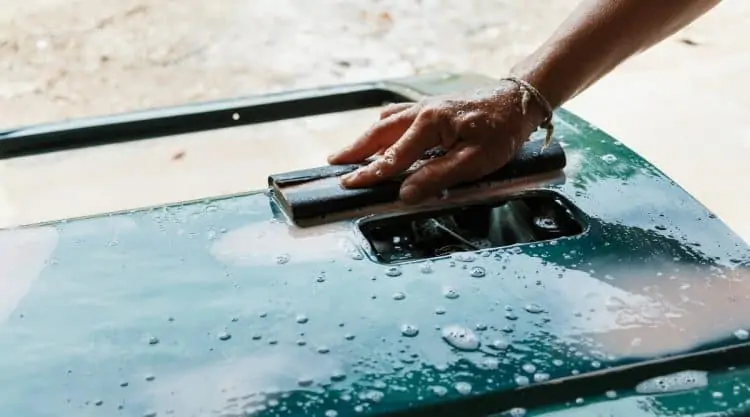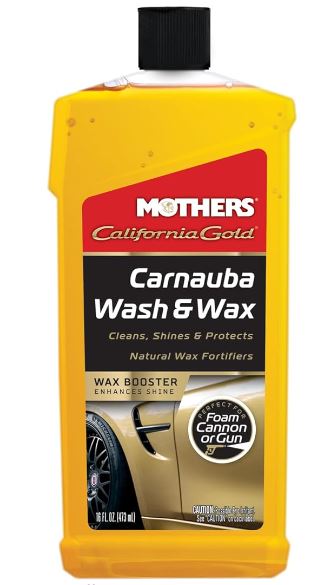Wet sanding could be the go-to process for removing scratches from your car’s paint. But should you use soap while you wet sand?
Is it okay to do wet sanding with soap?
Wet sanding with soap can produce a smooth, even finish on your car paint. Adding soap reduces the risk of damage and makes the sanding process more efficient. It’s best to use car wash soap, however, you can use detergent or dish soap too. Plus, using sandpaper with the right amount of grit adds more finesse to the whole process.
We have some great tips for you if you are unsure about using soap with wet sanding.
Can You Do Wet Sanding with Soap?

Not only can you do it, but it’s better to use soap while wet sanding your car. You can gain several advantages while adding soap to the wet sanding process.
Reason 1: Lubrication
Soap can help lubricate the sandpaper and reduce the heat and friction generated during the sanding process. This means adding soap makes it easier to work on the surface, reducing the risk of damage to the car’s paint and body.
Reason 2: Improved Finish
Wet sanding with soap can produce a smoother, better finish on a surface. This particularly applies when you are working with car paint.
Reason 3: Reduced Dust
Wet sanding with soap can help reduce the amount of dust generated during the sanding process. Because of this, it is easier to see and work on the surface.
Reason 4: Enhanced Cleaning
Adding soap can help clean and remove dirt, grime, and other contaminants from the surface while sanding the car’s paint. This can be especially useful when preparing a surface for painting or staining.
To sum up, wet sanding with soap is a very useful technique for producing a high-quality finish, especially on your car’s surface.
Furthermore, using soap with wet sanding reduces the risk of damage and makes the sanding process more efficient and easier.
A word of warning: Wet sanding is not the process of removing silicone from car paint. It’s completely different with another particular set of instructions.
What to Use When Wet Sanding with Soap?
As the name “wet sanding” suggests, you would need some sort of liquid and sandpaper. Also, you will need soap, as you know how much value it can add to your wet sanding process.
What Sandpaper Do I Use For Wet Sanding?
If you already know about sandpaper, you must know it comes in different varieties. The difference is in the grit of the sandpaper; different grits are used for different purposes.
Since there are a lot of different types of sandpaper, choosing the right one is crucial. So, before you attempt to wet sand, learn properly about sandpaper.
The grit of the sandpaper indicates the size of the abrasive particles that are attached to the paper. High grit means small abrasive particles. As a result, the scratches they leave behind are finer than those left by the smaller grit sandpaper.
Mainly, there are two types of sandpaper: microgrit and macrogrit. Since you want to wet sand your car, you only need microgrit sandpaper.
Now, there are also wide varieties of microgrit sandpaper, which can be confusing.
So, what grit sandpaper should you use for wet sanding clear coats?
For wet sanding a clear coat, you should start with 1000-grit sandpaper. Using this will remove the clear coat while finely smoothing out any imperfections. When you are done, take it up a notch by switching to 1500 for fine-tuning. If you need to blend two sanded areas, use 2000-grit sandpaper.
Also, what grit sandpaper to use for wet sanding car paint?
Wet sanding of car paint would be best with 2000-grit sandpaper. As you keep going, you can switch to 2500 or 3000-grit sandpaper for a smoother and finer finish.

What Liquid to Use For Wet Sanding?
The best liquid you can use for wet sanding is water. But since you will be using it on your car, deionized water would be the best choice.
If you do not want to spend money on deionized water every time, you can make a DIY water deionizer; it’s very simple and cost-efficient.
It’s best to add some car wash soap, which reduces scuffing and cleans the surface area. If you can’t get your hands on that, dish soap or detergent will also work.
Lucky for you, we know some great car wash products you can try:
How to Wet Sand a Car After Painting Using Soap?
You need to follow some strict instructions if you want to get the best results. So, here we have gathered all the steps for wet sanding with soap.
Tools needed:
Procedure:
Step 1: The first thing you will have to do is get a bucket full of water. Then add a small amount of car wash soap to it. Detergent or dish soap will also do.
Step 2: Now, soak all the sandpapers in the soap water for at least 30 minutes.
Step 3: Before wet sanding your car, ensure it is clean. If not, clean and dry it beforehand.
Step 4: To start, you need to use 1000-grit sandpaper. Take it and wrap it around the sandblock.
Step 5: Now, gently rub the surface in a straight line; do not be too harsh.
Step 6: When you are done, clean the surface area you just wet-sanded. Then, dry it with a microfiber cloth. This will reveal if you missed any spots.
Step 7: Now, switch to 1500-grit sandpaper to fine-tune your previous attempt. Repeat the same process.
Step 8: Clean and dry again with the microfiber cloth when you are done.
Step 9: The clear coat’s orange peel should be removed at this point.
Step 10: Now, use the 2000-grit sandpaper and repeat the same process. Clean and dry again for the finishing.
Step 11: Now, for a finer finish, use the 3000-grit sandpaper and polish the surface area.
That was all the instructions you needed for wet sanding with soap. The process is fairly straightforward and doesn’t involve any complications. Just be careful not to damage the base coat.
How To Know When To Stop Wet Sanding?
When wet sanding, it’s important to be attentive; otherwise, you can damage your base coat. Your car will have to be repainted to cover the damage you have done.
You can spray the surface area with water to check your work progress and then dry it with a microfiber cloth. This way, you will be able to see how much more you need to work on.
Also, the bucket water should turn somewhat milky when removing the clear coat. With no clear coat, the water should not change color.
In both cases, if there are color fragments in the water, you have damaged the car paint, which will have to be repainted.
How to Remove Haze After Wet Sanding?
To make your car shine brightly, you will need to remove the haze that is left behind due to wet sanding. For this, you will need a polishing compound. They are reasonably priced, so don’t worry about the budget.
Take a small amount of polishing compound on a clean cloth and put that on the surface you just wet-sanded. Then, rub it on the surface until no compound is left.
Doing this should remove the haze from wet sanding and restore the shine of your car’s paint.
A Few Points to Remember When Wet Sanding With Soap
Wet sanding is a sensitive process, so you must keep some things in mind. Here are five things you must know when wet sanding with soap.
Frequently Asked Questions (FAQs):
How do you get the shine back after wet sanding?
To get the shine back after wet sanding, use a soft, clean cloth or sponge to apply a small amount of polishing compound to the surface. Apply the wax or compound in a circular motion until it covers the entire surface.
Will wet sanding remove oxidation?
Yes, wet sanding can remove oxidation. The rubbing with the sandpaper loosens it up, and then the water finally removes it.
Will wet sanding get rid of orange peel?
You can remove the “orange peel” or the clear coat with wet sanding. To remove the “orange peel,” you need to start wet sanding with 1000-grit sandpaper, then use 1500-grit to fine-tune.
Conclusion
Wet sanding with soap is a very common and widely-used technique to enhance a sloppy paint job or remove any scratches from it. However, it is not mandatory to use soap during wet sanding. It does provide some extra lubrication and other benefits.
The wet sanding process does come in handy, but it’s a delicate procedure that needs caution and patience. So, if you’re not confident that you’re up for it, it’s better to hand it over to a professional.
As an Amazon Associate I earn from qualifying purchases.





